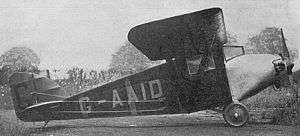ABC Robin
The ABC Robin was a British single-seat light aircraft designed by A. A. Fletcher in 1929. It was a high-wing, single-seat monoplane of conventional taildragger configuration.[1] The cockpit was fully enclosed, the first lightplane to be so equipped in Britain.[2] It was designed at the request of T. A. Dennis (managing director) specifically to use the firm's 30–40 h.p. Scorpion engine. Construction was primarily of wood with metal confined to fittings and a few highly stressed parts. The fuselage was constructed as a wooden box consisting of four spruce longerons with thin plywood covering with light internal bulkheads. The wood-framed wings, of RAF 34 section, were hinged at their inner rear corners to the top of the fuselage and supported by tubular struts in 'Vee' formation to the lower longerons of the fuselage. The tail was also wood-framed and both wings and tail were covered with doped fabric. The Robin, registered G-AAID, was built by ABC Motors Limited at Walton-on-Thames in 1929. The first flight was at Brooklands in June, and it was displayed at the Olympia Aero Show in July. It was modified later in the year with the windscreen moved back to allow access to the fuel filler caps from the outside, and with an enlarged fin and rudder. The sole Robin built was scrapped at Brooklands in 1932.
| Robin | |
|---|---|
 | |
| Role | Cabin monoplane |
| Manufacturer | ABC Motors Limited |
| Designer | Anthony "Tony" Archibald Fletcher |
| First flight | 1929 |
| Retired | 1932 |
| Status | Scrapped |
| Number built | 1 |
Specifications

Data from The Aeroplane 12 July 1928 – Performance figures are estimates
General characteristics
- Crew: one
- Length: 17 ft 4 in (5.28 m)
- Wingspan: 25 ft 4 in (7.72 m)
- Height: 5 ft 9 in (1.73 m)
- Wing area: 110 sq ft (10.23 m2)
- Aspect ratio: 5.83
- Airfoil: RAF-34[3]
- Empty weight: 415 lb (188 kg)
- Gross weight: 680 lb (308 kg)
- Powerplant: 1 × ABC Scorpion II piston engine, 40 hp (30 kW)
Performance
- Maximum speed: 105 mph (169 km/h, 91 kn)
- Range: 340 mi (545 km, 295 nmi)
- Service ceiling: 17,000 ft (5,200 m)
- Rate of climb: 750 ft/min (3.8 m/s)
Notes
- "none". Air Progress: 18. November 1978.
- Flight 30 May 1929 page 441 et seq
- Lednicer, David. "The Incomplete Guide to Airfoil Usage". m-selig.ae.illinois.edu. Retrieved 16 April 2019.
References
| Wikimedia Commons has media related to ABC Robin. |
- Jackson, A.J. (1974). British Civil Aircraft since 1919 Volume 1. London: Putnam. ISBN 0-370-10006-9.